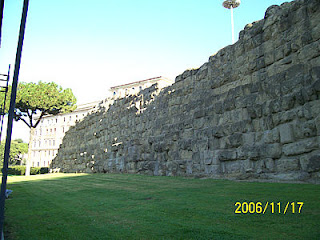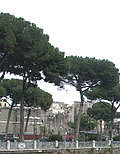
Our main aim in Rome was to see some of the ruins of ancient Rome. This remnant of the Servian Wall (in Latin: Murus Servii Tullii) is to be found next to the current main railway station, Stazione Termini.
The wall was a defensive barrier constructed around the city of Rome in the early 4th century BC. The wall was 3.6 m thick, 11 km long, and had more than a dozen gates. The Servian Wall is named after the sixth Roman King, Servius Tullius. The walls became unnecessary as Rome became well protected by the ever expanding military strength of the Republic and of the later Empire. As the city continued to grow and prosper, it was essentially unwalled for the first three centuries of the Empire. However, when the city came under attack from barbarian tribes in the 3rd century, Emperor Aurelian was forced to build the larger Aurelian Walls to protect Rome. The position of the walls influenced the naming of important buildings, which often have the equivalent of "inside the walls" or "outside the walls" tacked onto the name.

Not quite so ancient, but most imposing, is this column near the monument of Victor Emmanuel. Trajan's Column is a monument raised by Apollodorus of Damascus at the order of the Senate. It is located near the Quirinal Hill, north of the Roman Forum. It was completed in 113, the spiral bas-relief commemorates Trajan's victory in his military campaigns to conquer Dacia in the Dacian Wars.
The structure is about 30 meters in height, 38 meters including its large pedestal. The shaft is made from a series of 18 colossal Carrara marble drums, each weighing about 40 tons, with a diameter of about 4 meters. The 190 meter frieze winds around the shaft 23 times. Inside the shaft, a spiral staircase of 185 stairs provides access to a viewing platform at the top. Since there was a restoration project going on at the time we were there, we could not gain access.
Apparently the column was originally topped with a statue of a bird, possibly an eagle, and later by a heroically nude statue of Trajan himself. In 1588, it was replaced by a statue of Saint Peter (which still remains) by Pope Sixtus V.

The Piazza Venezia is bordered by Victor Emmanuel's monument to the south, the Palazzo Venezia to the north and Trajan's Column to the east. Directly south form Trajan's Column we came across a huge archaeological dig to unearth some remains of ancient Rome (in this picture we are looking towards the south), what used to be Trajan's Forum, Augustus's Forum and Ceasar's Forum. Just a little way further south along the Via Dei Fori Imperiali is the famous Colosseum.
So while I was tripping merrily along to take this photograph, with Willem waiting under a stand of trees closer to Trajan's Column, a protest march that had been in progress for some time finally reached Victor Emmanuel's monument. There they were stopped by a police cordon which by now also separated Willem and me, and they would not let me pass through to join Willem on the other side. We were quite some distance from the protesters and, one would have thought, obviously tourists. Anyway, I sidled along the back of a tree and snuck past when they weren't looking.

During the afternoon of Friday 17 November we joined a bus tour of Ancient Rome. The tour had two main stops, the Roman Forum and the Basilica of Saint Paul (more about the Basilica later). So here we are at the Colosseum, which is near the entrance to the ancient Roman Forum. To the left of this photo is the Arch of Constantine as seen from the Via Triumphalis.
The Colosseum, originally known as the Flavian Amphitheatre, is a giant amphitheatre in the centre of the city of Rome. Originally capable of seating 45,000 to 50,000 spectators, it was used for gladiatorial contests and public spectacles. It was built on a site just east of the Roman Forum, with construction starting between 70 and 72 AD under the emperor Vespasian. The amphitheatre, the largest ever built in the Roman Empire, was completed in 80 AD. It remained in use for nearly 500 years with the last recorded games being held there as late as the 6th century, well after the traditional date of the fall of Rome in 476.

We did not spend much time looking at the Colosseum, but proceeded through this gate, the Arch of Titus, (remains of the original city wall) to the Forum. The Roman Forum (Forum Romanum or Forum Magnum) was the central area around which ancient Rome developed, in which commerce, business, prostitution, cult and the administration of justice took place. Here the communal hearth was located. Sequences of remains of paving show that sediment eroded from the surrounding hills was already raising the level of the forum in early Republican times. Originally it had been marshy ground, which was drained. Its final travertine paving, still to be seen, dates from the reign of Augustus.

This photo shows the old Roman paving stones quite clearly. The hill opposite is the Palatine Hill, with the remains of the Temple of Vesta to the very left. The Temple of Vesta was built in the 3rd century B.C. It is not truly a temple because it was never inaugurated, nor did it hold a statue of Vesta, but only her sacred flame and the Palladium. The Palladium was a statue of Athena (Roman Minerva) believed to have been brought by Aeneas from Troy.
The Palatine Hill (Latin: Palatium) is the centermost of the seven hills of Rome and is one of the most ancient parts of the city of Rome. According to Roman mythology, the Palatine hill was where Romulus and Remus were found by the she-wolf that kept them alive. According to this legend, the shepherd Faustulus found the infants, and with his wife Acca Larentia raised the children. When they were older this is where Romulus decided to build Rome.
The three columns on the right are remains of the Temple of Vespasian and Titus.

The white marble Arch of Septimius Severus at the northeast end of the Roman Forum is a triumphal arch erected in AD 204 to commemorate the Parthian victories of Emperor Septimius Severus and his two sons, Caracalla and Geta, in the two campaigns against the Parthians of 195 and 203. In this photograph the monument of Victor Emmanual can be seen behind the arch.
During the Middle Ages, though the memory of the Forum Romanum persisted, its monuments were for the most part buried under debris, and its location was designated the "Campo Vaccino" or "cattle field". The return of Pope Urban V from Avignon in 1367 led to an increased interest in ancient monuments, partly for their moral lesson and partly as a quarry for new buildings being undertaken in Rome after a long lapse. Artists from the late 15th century drew the ruins in the Forum, antiquaries copied inscriptions in the 16th century, and a tentative excavation was begun in the late 18th century.

As an aside, we learnt that the Umbrella Pine is native to Italy, and the Italians are quite proud of these unusual-looking pines. Note our picture of the Colosseum also includes a couple of these trees. It is also called the Stone Pine (Pinus pinea). This tree has been exploited for its edible pine nuts since prehistoric times.
The tour guide told the story of Hitler being angry with Mussolini for planting the umbrella pines in Rome, because he believed that in this way Mussolini wanted to change the climate by increasing the rainfall in Italy, and that would turn Germany into a desert.

No comments:
Post a Comment